In this article, we share MP Board Class 12th Maths Book Solutions Chapter 1 Relations and Functions Ex 1.4 Pdf, These solutions are solved by subject experts from the latest MP Board books.
MP Board Class 12th Maths Solutions Chapter 1 Relations and Functions Ex 1.4
![]()
Question 1.
Determine whether or not each of the definition of * given below gives a binary operation. In the event that c is not a binary operation, given justification for this.
i. On Z+ define * by a * b = a – b
ii. On Z+, define * by a * b = ab
iii. On R, define * by a * b = ab²
iv. On Z+, define * by a * b = |a – b|
v. On Z+, define * by a * b = a
Solution:
i. Let 3, 4 ∈ Z+
3 * 4 = 3 – 4 = – 1 ∈ Z+
Hence * is not a binary operation.
ii. For every element a, b ∈ Z+, ab ∈ Z+
Hence * is a binary operation.
Example : 3, 4 ∈ Z+, 3 *4 = 3 x 4= 12 ∈ Z+
iii. For a, b ∈ R, ab² ∈ R and is unique.
Hence a * b = ab² is a binary operation,
Example : 5, b ∈ R, 5 * 6 = 5 x 6² = 180 ∈ R
iv. For a, b ∈ Z+, |a – b| ∈ Z+
Hence * is a binary operation.
Example : 3, 4 ∈ Z+, 3 * 4 = |3 – 4| = |- 1| = 1 ∈ Z+
v. For a, b ∈ Z++, a * b = 2 ∈ Z+
Hence * is a binary operation.
Example : 2, 3 ∈ Z+, 2 * 3 = 2 ∈ Z+
Question 2.
For each binary operation * defined below, determine whether * is commutative or associative.
i. On Z+, define a * b = a – b
ii. On Q, define a * b = ab + 1
iii. On Q, define a * b = \(\frac { ab }{ 2 }\)
iv. On Z+, define a * b = 2ab
v. On Z+, define a * b = ab
vi. On R – {- 1}, define a * b = \(\frac { a }{ b+1 }\)
Solution:
i. a * b = a – b; b * a = b – a
∴ a * b * b * a
∴ * is not commutative
Example:
2 * 3 = 2 – 3 = – 1 and 3 * 2 = 3 – 2 = 1
a * (b * c) = a – (b – c) = a – b + c
(a * b) * c = (a – b) – c = a – b – c
∴ a * (b * c) ≠ (a * b) * c
∴ * is not associative
ii. a * b = ab + 1
b * a = ba + 1 = ab + 1 since ab – ba in Q.
∴ a * b = b * a.
Hence * is commutative.
a * (b * c) = a * (bc + 1)
= a(bc + 1) + 1 = abc + a + 1
(a * b) * c = (ab + 1) * c
= (ab + 1)c + 1 = abc + c + 1
∴ a * (b * c) ≠ (a * b) * c
* is not associative.
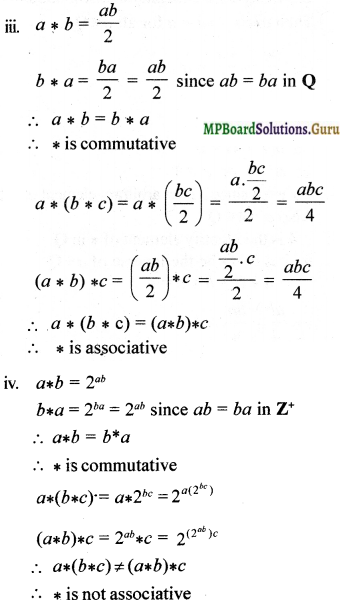
iv. a * b = 2ab
b * a = 2ba = 2ab since ab = ba in Z+
∴ a * b = b * a
∴ * is commutative
a * (b * c) = a * 2bc = 2a(2bc)
(a * b) * c = 2 ab * c = 2(2ab)c
∴ a * (b * c) ≠ (a * b) * c.
∴ * is not associative
v. a * b = ab
b * a = bb Since ab ≠ ba, a * b ≠ b * a
∴ * is not commutative.
Example :
2 * 3 = 233 = 8
3 * 2 = 3² = 9
∴ 2 * 3 ≠ 3 * 2
a * (b * c) = a * (bc) = a(bc )
(a * b) * c = (ab) * c = (ab)c = abc
∴ a * (b * c) ≠ (a * b) * c
∴ * is not associative
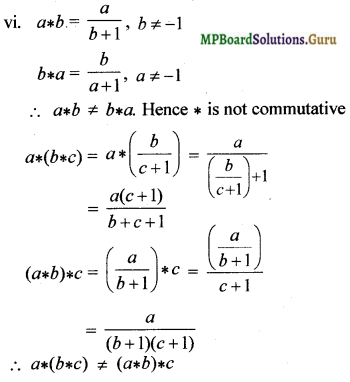
Hence * is not associative.
![]()
Question 3.
Consider the binary operation ^ on the set {1,2,3,4, 5} defined by a ^ b = min {a, b}. Write the operation table of the operation ^ .
Solution:
1 ^ 1 = min{1, 1} = 1, 1 ^ 2 = min{1, 2} = 1, etc.
2 ^ 1 = min{2, 1} = 1, 2 ^ 2 = min{2, 2} = 2, etc.
3 ^ 1 = min{3,1} = 1, 3 ^ 2 = min{3, 2} = 2, etc. and so on.
The operation table of the operation.
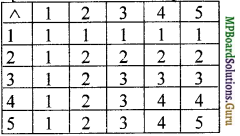
Question 4.
Consider a binary operation * on the set {1, 2, 3, 4, 5} given by the following multiplication table
i. Compute (2 * 3) * 4 and 2 * (3 * 4)
ii. Is * commutative?
iii. Compute (2 * 3) * (4 * 5).
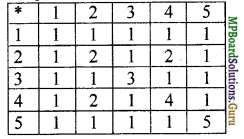
Solution:
i. (2 * 3) * 4 = 1 * 4 = 1
2 * (3 * 4) = 2 * 1 = 1
ii. The entries in the table are symmetric along the main diagonal. Hence * is commutative.
iii. (2 * 3) * (4 * 5) = 1 * 1 = 1
Question 5.
Let *’ be the binary operation on the set {1, 2, 3, 4, 5} defined by a *’ b = H.C.F. of a and b. Is the operation *’ same as the operation * defined in Question 4 above? Justify your answer.
Solution:
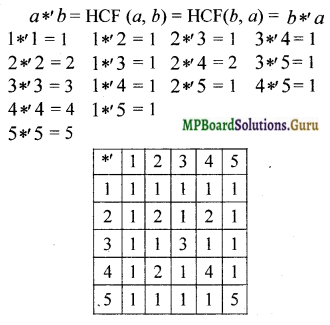
*’ gives the same table as given in. Hence * and *’ are the same operations.
![]()
Question 6.
Let * be the binary operation on N given by a * b = L.C.M. of a and b. Find
i. 5 * 7, 20 * 16
ii. Is * commutative?
iii. Is * associative?
iv. Find the identity of * in N
v. Which elements of N are invertible for the operation *?
Solution:
i. 5 * 7 = LCM (5, 7) = 5 x 7 = 35
20 * 16 = LCM (20, 16) = 80
ii. a * b = LCM (a, b)
b * a = LCM (b, a) = LCM (a, b)
∴ a * b = b * a
∴ * is commutative
iii. a * (b * c) = a * LCM (b, c)
= LCM (a, b, c)
(a * b) * c = LCM (a, b) * c
= LCM (a, b, c)
∴ a * (b * c) = (a * b) * c
∴ * is associative
iv. Let e be the identity element in N.
Then a * e = e * a = a, for all a ∈ N
⇒ LCM (a, e) = a, for all a ∈ N
⇒ e = 1 ∈ N
∴ 1 is the identity element of * in N.
v. Let a be an invertible element in N.
Then there exists an element b in N such that
a * b = 1 = b * a
⇒ LCM (a, b)= 1
a = b= 1
Thus 1 is an invertible element in N.
Question 7.
Is * defined on the set {1, 2, 3, 4, 5} by a * b = L.C.M. of a and b a binary operation? Justify your answer. (March 2016)
Solution:
a * b = LCM (a, b)
Now 2 * 3 = LCM (2, 3) = 6
But 6 is not an element of the given set.
Hence * is not a binary operation.
Question 8.
Let * be the binary operation on N defined by a * b = H.C.F. of a and b.
Is * commutative? Is * associative?
Does there exist identity for this binary operation on N? (March 2013)
Solution:
a * b = HCF (a, b) for all a, b ∈ N
b * a = HCF (b, a) for all a, b ∈ N
∴ a * b = b * a
∴ * is commutative
a * (b * c) = a * HCF (b, c)
= HCF (a, b, c)
(a * b) * c = HCF (a, b) * c = HCF (a, b, c)
Hence a * (b * c) = (a * b) * c
∴ * is associative
Let e be the identity element in N.
⇒ a * e = e * a = a for all a ∈ N
⇒ HCF (a, e) = HCF (e, a) = a for all a ∈ N
⇒ There is no e e N which makes this true.
⇒ Identity element does not exist in N.
Question 9.
Let * be a binary operation on the set Q of rational numbers as follows:
i. a * b = a – b
ii. a * b = a² + b²
iii. a * b = a + ab
iv. a * b = (a – b)²
v. a * b = \(\frac { ab }{ 4 }\)
vi. a * b = ab²
Find which of the binary operations are commutative and which are associative.
Solution:
i. a * b = a – b b * a = b – a
Hence a * b ≠ b * a
∴ * is not commutative
a * (b * c) = a* (b – c)
= a – (b – c) = a – b + c
(a * b) * c = (a – b) * c = (a – b) – c = a – b – c
Hence (a * b) * c ≠ a * (b * c)
∴ * is not associative.
ii. a * b = a² + b²
b * a = b² + a² = a² + b² = a * b
∴ * is commutative.
a * (b * c) = a * (b² + c²) = a² + (b² + c²)²
(a * b) * c = (a² + b²) * c
= (a² + b²)² + c² ≠ a² + (b² + c²)²
∴ * is not associative
iii. a * b = a + ab;
b * a = b + ba
a * b ≠ b * a
∴ * is not commutative.
a * (b * c) = a * (b + bc)
= a + a(b + bc) = a + ab + abc
(a * b) * c = (a + ab) * c
= (a + ab) + (a + ab)c
= a + ab + ac + abc
a*(b + c) ≠ (a * b) * c
∴ * is not associative.
iv. a * b = (a – b)² = a² – 2ab + b²
b * a = (b – a)² = b² – 2ab + a²
= a² – 2ab + b² = a * b
∴ * is commutative.
a * (b * c) = a * (b – c)² = [a – (b – c)²]²
(a * b) * c = (a – b)² * c = [(a – b)² – c]²
a * (b * c) ≠ (a * b) * c
∴ * is not associative.
v. a * b = \(\frac { ab }{ 4 }\)
b * a = \(\frac { ba }{ 4 }\) = \(\frac { ab }{ 4 }\) = a * b
∴ * is commutative.
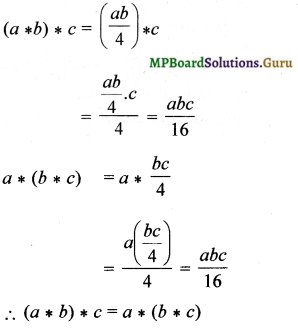
vi. a * b = ab² ; b * a = ba²
a * b ± b * a
∴ * is not commutative.
a * (b * c) = a * (bc²) = a(bc²)² = ab²c4
(a * b) * c = (ab²) * c = (ab²)(c²) = ab²c²
a * (b * c) ≠ (a * b) * c
∴ * is not associative.
![]()
Question 10.
Show that none of the operations given in Qn.No. 9 (except (v)) has identity.
Solution:
i. Let e be the identity element.
a * e = e * a = a
⇒ a² + e² = e² + a² = a
which is not possible for any e ∈ Q.
∴ There is no identity element.
ii. Let e be the identity element.
a * e = e * a = a
⇒ (a – e)² = (e – a)² = a
which is not possible for any e ∈ Q.
∴ There is no identity element. .
iii. Let e be the identity element.
a * e = e * a = a
⇒ ae² = ea² = a
which is not possible for any e ∈ Q. (SAY 2014)
∴ There is no identity element.
Question 11.
Let A = N x N and * be the binary operation on A defined by (a, b) * (c, d) = (a + c, b + d)
Show that * is commutative and associative. Find the identity element for * on A, if any.
Solution:
(a, b) * (c, d) = (a + c, b + d)
(c, d) * (a, b) = (c + a, d+ b) = (a + c, b + d)
(a, b) * (c, d) = (c, d) * (a, b)
∴ * is commutative.
Let (a, b), (c, d), (e, f) ∈ A.
(a, b) * [(c, d) * (e, f)]
= (a, b) * [(c + e, d +f)]
= (a + c + e, b + d +f)
[(a, b) * (c, d)] * (e, f) = (a + c, b + d) * (e, f)
= (a + c + e, b + d + f)
i.e., (a, b) * [(c, d) * (e, f)] = [(a, b) * (c, d)] * (e, f)
∴ * is associative.
Here identity element does not exist.
Let (e1, e2) ∈ be the identity element for * in A.
∴ (a, b) * (e1 + e2) = (e1, e2) * (a, b) = (a, b)
⇒ (a + e1, b + e2) = (e1 + a, e2 + b) = (a, b)
⇒ a + e1 = a and b + e2 = b
⇒ e1 = 0 and e2 = 0
(e1, e2) = (0, 0) ∉ A, since A = N x N
Hence there is no identity element for * in A.
Question 12.
State whether the following statements are true or false. Justify.
i. For an arbitrary binary operation * on a set N, a * a = a for all a ∈ N
ii. If * is a commutative binary operation on N, then
a * (b * c) = (c * b) * a.
Solution:
i. False
Let a * b = a + b, a, b ∈ N
∴ a * a = a + a = 2a ≠ a
ii. True
Since * is commutative b * c = c * b
∴ a * (b * c) = a * (c * b) = (c * b) * a
![]()
Question 13.
Consider a binary operation * on N defined as a * b = a³ + b³. Choose the correct answer.
a. Is * both associative and commutative?
b. Is * commutative but not associative?
c. Is * associative but not commutative?
d. Is * neither commutative nor associative?
Solution:
b. Is * commutative but not associative?
a * b = a³ + b³ = b³ + a³ = b * a
∴ * is commutative.
a * (b * c ) = a * (b³ + c³) = a³ + (b³ + c³)³
(a * b) * c = (a³ + b³) * c = (a³ + b³)³ + c³
* is not associative.